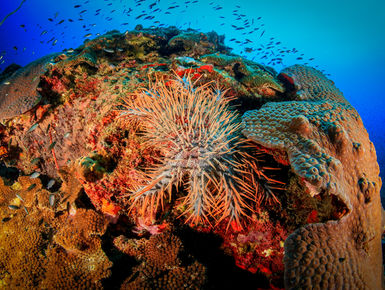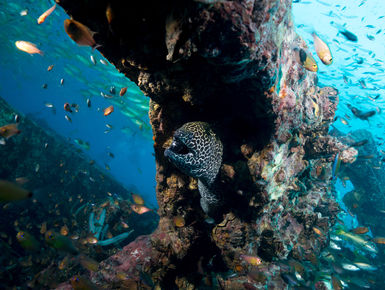
Bright Reefs, Warm Waters and Colorful Creatures
From shallow, sunlit reefs to current-washed pinnacles, wrecks, deep walls, caverns, and grottoes, Thailand has all the settings needed for a world-class dive destination. And that includes the marine life, which comes in an impressive array of types and sizes from tiny invertebrates to bus-sized whale sharks. These facts are not lost on the ever-growing number of visitors who are drawn to locations all across the expansive Gulf of Thailand and the eastern edge of the Andaman Sea. Here, they find a well-developed dive infrastructure that provides access to a wide range of sites within the country's extensive network of marine reserves. Ashore, all the experiences of one of Asia's most intriguing cultures await discovery.
Highlights
- Best for: All divers
- Best season to visit: November to April for the Similan Islands. Year round for the Gulf of Thailand and the central Andaman Sea
- Weather: Expect warm days in the mid 80s to low 90s year round. January to May are the driest months, with more rain from June to November, and heaviest perceptional in September and October from the southwest monsoon
Things to Do
- • Jungle safaris
- • River cruises
- • Elephant rides
- • Temple tours
- • Water sports
- • Fishing
Thailand Information
About Diving in Thailand
With 2,000 miles of coastline and thousands of small offshore islands to explore, Thailand offers a wide and diverse range of diving experiences. The country's well-developed dive infrastructure ranges from simple dorm-style lodges to full-service resorts. Many coastal sites along the Gulf of Thailand are devoted to dive instruction, with more seasoned divers focusing on sites around offshore islands. On the western side of the Malay Peninsula, the region around Phuket and Lao Lak is considered the best for both day trips and liveaboard departures to the Similan Islands. Water temperatures in the Bay of Thailand remain in the low to mid 80s. The Andaman Sea occasionally dips below 80 in January and warms to 85 in summer.
Diving in Thailand Tips
To English speakers, the names of many of Thailand's dive sites can seem confusingly similar. Adding to this confusion is the fact that names are sometimes translated in different ways. Racha may also be spelled as Rajah and Raya, and the Phi-Phi Islands are also spelled Pee-Pee. When reading about local dive sites it helps to learn a few Thai words. Ko or Koh means Island, Ao means beach, Hin means Rock, Yai means large, and Noi means small.
Best Places to Dive in Thailand
The towering granite obelisks at Chumphon Pinnacle are carpeted in multi-hued anemones and sponges. Adrift along the wall at Koh Dok Mai reveals eels and nurse sharks lurking in hidden caves and crevices carved into the limestone rock face. Exceptional water clarity allows sunlight to showcase the full colors of the reefs at Racha Yai. Mantas cruise the deepwater rocks of Hin Daeng and Hin Muang, while Richelieu Rock attracts whale sharks, tornado-shaped barracuda schools and clouds of tropical fish. It also holds small treasures such as shovelnose rays, seahorses, pipefish and cuttlefish. Bida Nok amazes above the water and rewards below with curiosities such as sea snakes, leopard sharks and giant clams.
What to Pack for Diving in Thailand
A light neoprene or synthetic body suit will provide streamlining and exposure protection in the warm waters of the Gulf of Thailand, while a 3mm wetsuit might be called for in the Similan Islands in winter months. Bring a hat and tropical-weight cover up for sun protection on longer boat rides.
Liveaboards

Thailand
The Phinisi
Book on-line or Contact Caradonna Adventures at 800.328.2288 or email us sales@caradonna.com.
Call 800-330-6611 for Special Pricing and Information.
See Packages & Learn More
Thailand
Thailand Aggressor
Call 800-330-6611 for Special Pricing and Information.
See Packages & Learn MoreDiving in Thailand
Thailand has 1,700 miles of coastline that wrap around the Gulf of Thailand, and another 300 miles of shore on the Andaman Sea. A full list of the country's dive sites and dive-centric businesses is almost overwhelming, as most every seaside village and resort area along both coasts will likely have several boats offering dive charters, hotels or hostels catering to divers, and scuba schools that put tens of thousands of first-time divers in the water each year. The choices become easier for travelers who are visiting Thailand specifically for its underwater attractions. If choosing the Gulf, they favor offshore islands such as Koh Phangan, Koh Tao and Ko Samui, which include shallow reefs covered in riotous pallets of whip corals, sponges and soft corals; slopes riddled with dramatic swim-throughs and caverns; and pinnacles blanketed in huge schools of barracuda. Whale sharks are occasionally seen in these waters, and black tip reef sharks are common. Favorite sites include Sail Rock and the Angthong Marine Park. 3 In all, there are 27 marine parks in Thailand—10 in the Gulf, the other 17 in the Andaman Sea. The epicenter of diving activity is the west-central coast of the Malay Peninsula, on Phuket Island and north of the town of Khao Lak, some 50 miles to the north. Phuket offers reefs, slopes, walls, pinnacles, wrecks and an underwater sculpture park. Two signature sites are Shark Point and Anemone Reef, which offer rare corals and an abundance of sharks. Boats depart for islands such as Racha Yai, which offers year-round water clarity and postcard-perfect shallow reefs. One of the area's premier destinations is the Phi Phi Islands, which have often been called are one of the most dramatically beautiful locations in the world. Above the surface, rock cliffs rise from emerald waters to heights of more than 1,000 feet. Underwater, these limestone cliff faces become vertical walls eroded with caves, overhangs, and swim-throughs, all covered with a profusion of soft corals, black corals and undulating sea whips. Water clarity around these islands is often less than in other areas near Phuket, but the dramatic topographies and colors more than compensate. To the north, Khao Lak is the starting point for day trips to the Similan Islands, and liveaboard excursions more remote sites such as to Richelieu Rock, Koh Tachai and Koh Bon. The Similan archipelago is one of the most sought after dive destinations in Asia. This cluster of nine granite islands lies within a National Park located 50 miles off the coast and some 60 miles north of Phuket. The area is famous for the diversity of marine life, colorful shallow reefs and dramatic deep sites. The eastern sides of these islands feature hard coral gardens on slopes to depths of 100 feet. Here, divers will find everything from ghost pipefish to giant bump head parrotfish, and white tip and leopard sharks are common. Western sides of the islands and points such as Elephant Head Rock offer more exciting diving, with currents that swirl around large sunken granite boulders, and arches, tunnels and swim-throughs clogged with enormous sea fans. March and April are prime months for the Similans, as this marks the arrival of whale sharks and large manta rays.
Passport and/or Visa Requirements
Entry/Exit Requirements: All U.S. citizens are required to present a valid passport that must be valid for 6 months beyond your date of entry into the country. Proof of onward or return ticket and at least 1 blank page is required in your passport for entry stamp. There is no visa required for stays less than 30 days.
Immunizations
Although no vaccines are required for entry into Thailand, you should check with your doctor and the Centers for Disease Control on recommended vaccinations for travel at cdc.gov.
Culture and Customs
In a region heavily influenced by Colonial powers from both East and West, the Kingdom of Thailand, long known as Siam, remained true to it’ cultural roots. In a country that is more than 90 percent Theravada Buddhist, the belief system and values of that religion play a huge role in day-to-day life. Most important to the Thai people are the virtues of respect, self-control, and non-confrontation. Equally important is the concept of Sanuk, which is a positive and life-affirming belief that life should be fun. This playful attitude is manifest in all aspects of day-to-day life. Another distinctive cultural trait is the wai, which is a prayer-like gesture with the hands that may be accompanied by a slight bow and a smile, indicating a person's welcoming and pleasant attitude. Also common is the word “wawatdee”, which is a universal greeting that can mean hello, good day, good morning, good afternoon or goodbye. Such cultural traditions may seem at odds with the high-energy bustle of cities such as Bangkok, but they become more apparent as one escapes the major commercial centers and enters the countryside. Visitors who display a reasonable degree of cultural sensitivity will discover the Thai people to be extremely warm and accommodating. Even warmer are the soups, curries and noodle dishes that are icons of Thai cuisine. From internationally-known favorites such as Pad Thai to regional favorites such as Tom Yam, Khanom Maw Kaeng and Khao Soi. When ordering, it may be prudent to start with dishes that are mai phet—not spicy—or phet nit—a bit spicy. Only the brave, or foolish, will order their food phet man, aka “Thai hot.”
Electricity, Phone and Internet Access
Electricity in Thailand is 220 volts, 50 Hz. Sockets feature a 2 prong round or flat plug so an adapter will be needed for U.S. electronics. Any device that does not accept 220V input may also need a step down transformer. The country code for Thailand is 66. Check with your cell phone provider for International plans for text, voice and data. WiFi is available at many resorts and restaurants.
Water Quality
In general, people in Thailand do not drink the tap water. Bottled water is recommended and readily available for purchase.
Language & Currency
Thai the official language for Thailand. English is the unofficial second language. The local currency is the Thai Bhat (THB) pronounced baaht. Check the current exchange rate here. Coins come in denominations of 1, 2 ,5 & 10 baht and 25 and 50 satang, while bank notes come in denominations of 20, 50, 100, 500 and 1,000 baht. ATMs are plentiful in Thailand using major network cards and Credit cards are accepted at most hotels.
Time
Thailand utilizes Indochina Time or ICT which is 7 hours ahead of Greenwich Mean Time.(+7 GMT) Thailand does not observe Daylight Savings Time.
Location, Size and Population
Thailand is located in Southeast Asia, bordered by the Andaman Sea, Indian Ocean and the Gulf of Thailand. It borders the countries of Burma (Myanmar), Laos, Cambodia & Malaysia. The capital city is Bangkok and the size is approximately 200,000 square miles - a little larger than California.
The population of Thailand is over 68 Million (2016).



